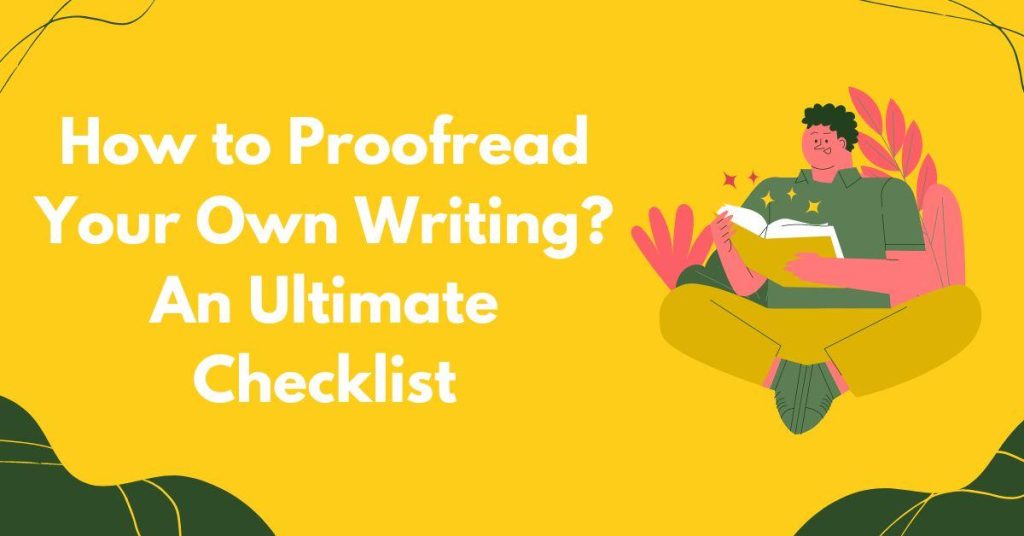|
Download ESL Books + Free PDFs
ESL Vocabulary Flashcards Download free flashcards & PDFs! |

Proofreading means reviewing your content once you have finished writing it. It is a very important measure for ensuring that your work has no errors
According to an online source, 54% of employers will think twice about hiring you if your content has a spelling or grammar mistake.
It is crucial that you proofread your writing once or twice because of this. You may come across mistakes like misspellings and grammar, unclear sentence construction, and much more during this process.
So how to proofread your work? In this article, we have created a list of effective methods to help you proofread your work most efficiently.
1. Take a Break
After finishing your work, it’s crucial that you take a break and don’t start proofreading straight away. This is essential because, when you return from your break with a clear head, you will be able to spot all of the writing errors.

During this break, make sure that you are not thinking about your writing. Try to divert your focus by engaging in activities that interest you.
Similarly, you need to be careful not to take extra-long or overly short breaks. The duration of your break can be determined by the length of your writing. For example, a thousand-word article might require a break of several hours before you proofread it.
2. Read Aloud
This approach may appear a little odd at first, but it has many benefits. You can get a sense of how your writing sounds to a reader by reading it aloud. This step is most effective in finding readability errors.

For example, using complex or compound sentences might be good in some cases, but sometimes, they might confuse the users. Such confusing sentences can be identified by reading your work aloud. Similarly, you might come up with a few synonyms that can replace some words.
3. Make a Checklist

One thing that might help you while proofreading is to make a checklist of errors that you want to find in your writing. Your proofreading checklist might look something like this:
- Spelling errors
- Grammar mistakes
- Readability issues
- Word choice
You can proofread your writing multiple times, concentrating on one kind of mistake at a time. Although it may take some time, the outcomes will be well worth it.
However, you can skip this step and search for all errors at once if you don’t have much time to spare for the proofreading process.
4. Read Backwards
This is a very effective technique for finding out errors while proofreading. What this means is that instead of reading your content in chronological order, you can start from the end and read the previous sentences.
By not following the order of your writing, you can read sentences without context. This allows you to proofread sentences as individual phrases instead of parts of a paragraph. In this way, you can catch errors in your sentences much more efficiently.

One variant of this method is to read a sentence and then read the same sentence backward. For example, the sentence, the mobile is red can be read backward as red is the mobile. This technique is also useful but takes up quite some time.
5. Use Proofreading Tools
There are several different proofreading tools available on the internet. These can identify mistakes in your work, and some might even suggest suitable replacements to fix those errors.
These tools can include grammar or spell checkers, readability checkers, plagiarism checkers, etc. We have listed a few such tools to familiarize you with how they identify mistakes in your work.
Now let’s briefly discuss all of them one by one.
A. Editpad Plagiarism Checker
An online plagiarism detector provided by Editpad examines your writing to see if any of the content matches that found in any other online source. This tool guarantees the originality and distinctiveness of your work in this way.
Here is an example of how its reports look like:

With the help of this tool, we were able to identify that our passage was not plagiarized.
B. Grammarcheck.ai
This program is a grammar checker that can identify errors in your writing and recommend appropriate substitutions for them. With the help of this tool, errors can be found and corrected.
Here is an example of its working:

In the above example, the tool was able to detect grammar errors. Both the subject-verb agreement error and the incorrect capitalization were pointed out, and a list of replacements was also provided.
C. Prepostseo Readability Checker
The readability checker by Prepostseo gives you a readability score. This score can help you determine whether your sentences are easy to read and understand or not.
Here are what its results look like:

These are the statistics that were shown to us when we entered a sentence into the tool.
D. HemingwayApp
Our last example is the online text editing software known as Hemingway App. This tool also gives you the readability check of your sentences along with some other statistics. An image of these statistics has been given below.

The red arrow points to the metrics that this tool measures and lets us know about.
So, by using these tools, you can save some time and find out all the errors that are present in your writing.
6. Ask For Feedback
Reviewing your work by yourself is very important, but taking someone else’s opinion on your writing before publishing it can be very valuable as well. You can ask someone from friends or family to give you unbiased feedback.

They might find out some mistakes that you have overlooked or didn’t consider mistakes at all. For example, a sentence might sound right to you because your reading skills are high, but the same sentence might be confusing for some readers. So, be open to constructive criticism and make relevant changes according to the third-person reviews.
7. Final Review
Once you are done making all the changes, review your edited work one final time. This will further eliminate the possibility of your work having any sort of errors.
Similarly, there might be some changes that you had identified before but forgot to add. That’s why a final review can be very helpful in some cases.
Conclusion
In this article, we have discussed a few strategies you can apply for proofreading your work. Similarly, we have explained the importance of proofreading and why it is important. Your writing reaches its finalized form only when it has been carefully proofread. That’s why you should always analyze your work thoroughly before submitting or publishing it.
